Cooler Master Shows Concept Coolers: Closed-Loop Heat Pipe and Flying Saucer
by Anton Shilov on June 8, 2017 1:00 PM EST- Posted in
- Cases/Cooling/PSUs
- Cooler Master
- cooling
- Computex 2017
- 3DLV
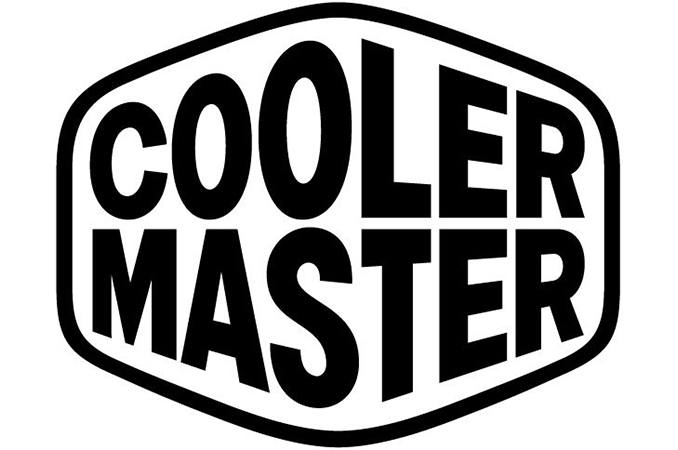
Hardware manufacturers use trade shows not only to display upcoming commercial products, but also to demonstrate and collect feedback on concept devices that may or may not become full commercial products. Cooler Master used Computex to demo two of its concept coolers, one of which featured a closed-loop heat pipe along with three fans, another used a large heat column and a rather unarthodox design.
Although many performance enthusiasts nowadays choose all-in-one liquid cooling solutions over air coolers because of dimensions and efficiency, oversized CPU tower coolers still have their own advantages: there is no risk of leaking, they are large and therefore they can cool down chips even if their fans fail, they are rather affordable too.
The MasterAir Maker 3DLV is one of Cooler Master’s concept coolers. It has two large radiators connected together using four closed-loop heat pipes and featuring three 120-mm fans. The main idea of heat pipes is to quickly transfer heat from the bottom of the cooler to fins located along the path of the pipes, away from the heat source. Closed-loop heat pipes have been explored by multiple companies and Zalman’s CNPS 9000-series coolers actually take advantage of them. The CNPS 9000's are round and the closed-loop heat pipes actually transferred heat to all fins. Meanwhile, CM’s 3DLV concept cooler is rectangular and does not have any fins on its top, just bare pipes and we have no idea how efficient such a configuration is. Still, three fans should ensure rather high efficiency anyway and the manufacturer promises that the cooler can remove up to 200 W of heat.
In the meantime it is unclear whether Cooler Master will actually commercialize this model, as due to its large dimensions it is not compatible with high-end memory modules that have large heatspreaders.
Meanwhile the Heat Column Concept is another cooler that CM demonstrated at Computex. This cooler resembled a flying saucer and featured a huge heat column on its base. The flying saucer cooler is made of copper and therefore quickly absorbs heat. The producer rates the device at 100 W TDP, which means that it can cool down all mainstream CPUs in the AM4 and LGA1151 form-factors from both manufacturers.
Cooler Master has not decided the final specs of the cooling solution or how to position it yet. One of the things the company’s engineers are thinking about are dimensions: they could make the “saucer” smaller and position it for, say, Mini-ITX system, or make it larger and then appeal to overclockers/modding community.
One of the things that the triple fan and the saucer coolers integrate is user-configurable RGB LED lighting, which is becoming an important feature. Because enthusiasts appreciate customizable lighting, it makes sense for Cooler Master to offer it not only with new cases, but also with CPU coolers.
Related Reading:
- Scythe Announces Mugen 5 CPU Cooler: New Design, Fan and Mounting
- The 140mm Slim Tower CPU Cooler Roundup: Thin & Light Done Just Right
- Top Tier CPU Air Coolers Q3 2015: 9-Way Roundup Review
- Battle of The CPU Stock Coolers! 7x Intel vs 5x AMD, plus an EVO 212
- Alpenföhn Unveils Olymp: A Giant Air Cooler Rated for 340W TDP
- CPU Air Cooler Roundup: Six Coolers from Noctua, SilverStone, be quiet!, and Cooler Master
Source: Cooler Master



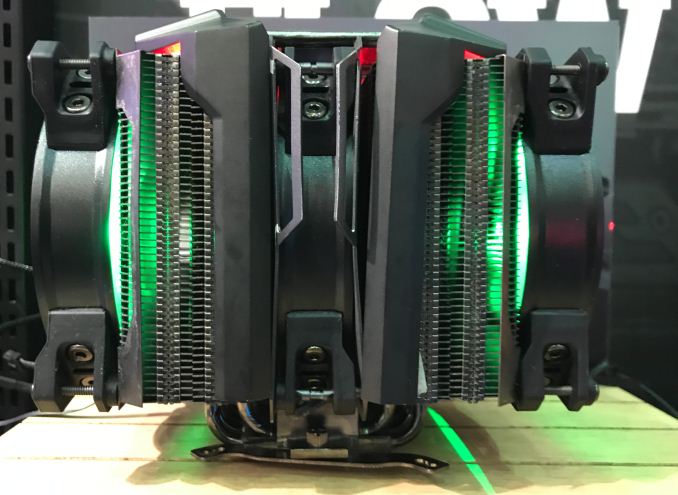
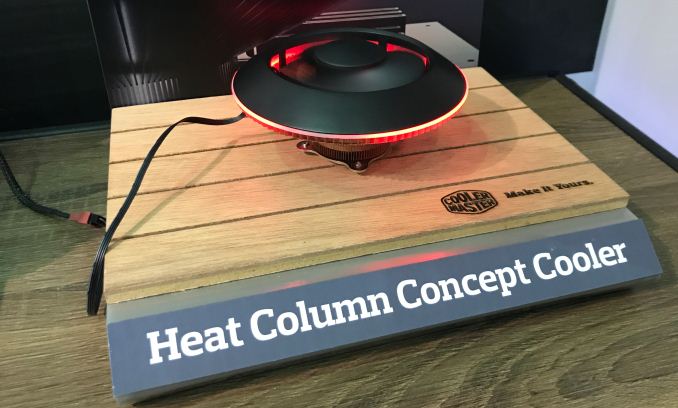
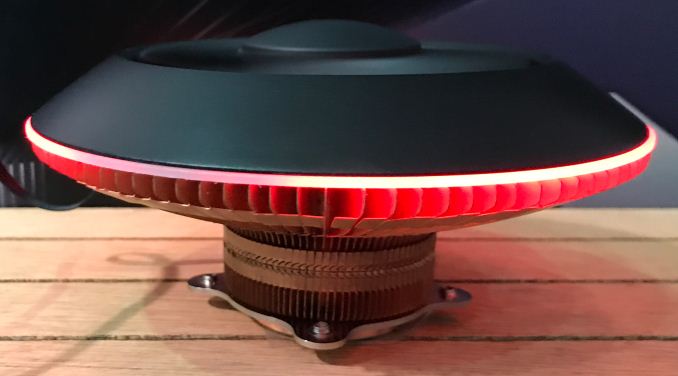
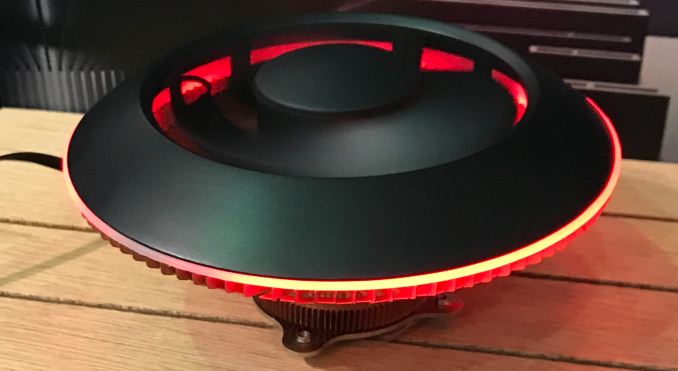








17 Comments
View All Comments
close - Thursday, June 8, 2017 - link
At least the saucer has an interesting design...edzieba - Thursday, June 8, 2017 - link
"closed-loop heat pipes"All heat-pipes are by definition closed-loop, or they would be ejecting a continuous stream of working fluid. They might mean heat-pipes with separate vapour and liquid phase paths (rather than the combined paths we are used to using internal grooved or sintered wicking) but that does not appear to be the case from the photos.
MajGenRelativity - Thursday, June 8, 2017 - link
I think the author means that the heat pipes do not have ends, and connect to each other. And by "don't have ends" I don't mean that the pipes are unsealed, just that they form a complete circle.close - Thursday, June 8, 2017 - link
Heatpipes themselves - the metal tubes - are rarely closed loops. They're usually tubes with two sealed ends, one at the base of the cooler and the other at the top. This time they are a continuous closed loop, no ends.The "loop" you're thinking of is the cycle inside the heatpipe.
MrSpadge - Thursday, June 8, 2017 - link
Does anyone know the benefit of using these "closed loop" heatpipes? In a regular heatpipe the vapor will find its way anyway and the liquid only occupies a small volume, so both streams should hardly conflict. I also don't see the point of offering the cooled liquid an additional path to the COOL top side of the cooler. What is is supposed to do there? Flow to the other fin block, where the other stream of hot vapour is already condensing? Gravity doesn't have much influence on the movements inside the heatpipes, as the other forces are much larger (if it's well constructed).MrSpadge - Thursday, June 8, 2017 - link
BTW: 200 W for such a massive cooler with 3 fans isn't all that impressive, so the "closed loops" can't be of that much help.close - Thursday, June 8, 2017 - link
Probably for aesthetic effect. Without additional fins the bare heatpipes at the top would hardly make a difference.Valantar - Thursday, June 8, 2017 - link
Does anyone know what a 'heat column' is? I certainly don't, and the article doesn't exactly go out of its way to explain the concept.Chaitanya - Friday, June 9, 2017 - link
check frosty techs article: Cooling Overview 2004. Also thermal column with reference to atmosphere is: A thermal column (or thermal) is a column of rising air in the lower altitudes of Earth's atmosphere, a form of atmospheric updraft. Thermals are created by the uneven heating of Earth's surface from solar radiation, and are an example of convection, specifically atmospheric convection. The Sun warms the ground, which in turn warms the air directly above it.Rocket321 - Thursday, June 8, 2017 - link
A couple of questions based on the text:closed-loop heat pipe - what's different from the heat pipes we've been using for the last decade?
heatcolumn - what's this?